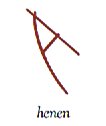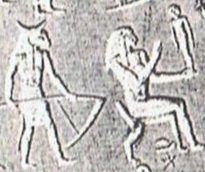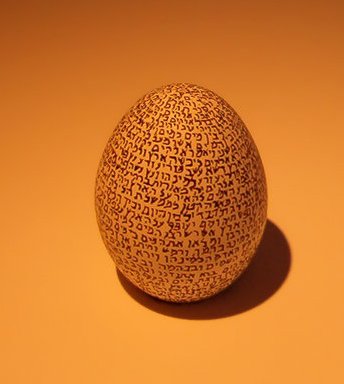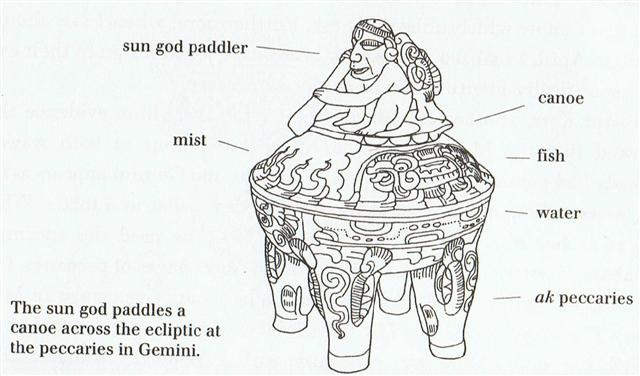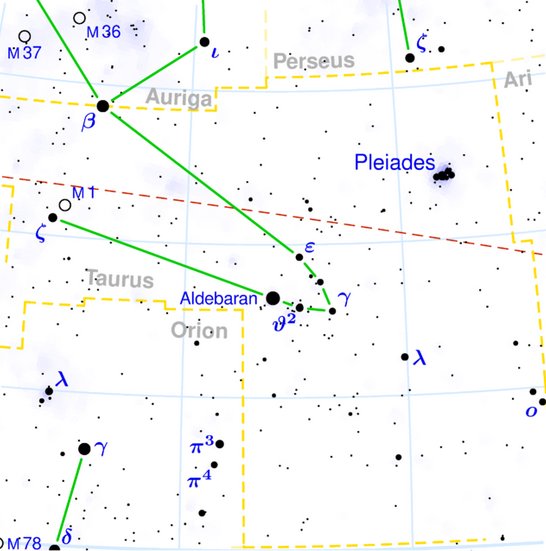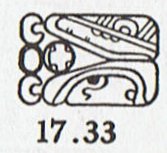*62 (the Egg in Eridanus, 20 he mamari kiakia.) + *115 (cycle of Mercury) = *177 = *354 / 2. And 3 * 115 = 345 (→ 3 * 3 + 4 * 4 = 5 * 5) = 365 - 20. I.e., Cosmos ought in principle to have a score of days when Rongo was invisible - out of sight because he was 'asleep' below the surface of the earth. ... Using an unworked branch of the mapou tree - should we not thus say, a bough broken from a sacred tree? - a second priest, representing Tuu, removes, binds up, and then reburies the first sweet-potato tubers. He so kills Rongo, the god, parent and body of the sweet potato, or else puts him to sleep, so that man may harvest the crop to his own use ...
... Man, then, lives by a kind of periodic deicide. Or, the god is separated from the objects of human existence by acts of piety that in social life would be tantamount to theft and violence - not to speak of cannibalism. 'Be thou undermost, / While I am uppermost', goes a Maori incantation to the god accompanying the offering of cooked food; for as cooked food destroys tabu, the propitiation is at the same time a kind of pollution - i.e., of the god. The aggressive relation to divine beings helps explain why contact with the sacred is extremely dangerous to those who are not themselves in a tabu state. Precisely, then, these Polynesians prefer to wrest their existence from the god under the sign and protection of a divine adversary. They put on Tuu (Kuu), god of warriors. Thus did men learn how to oppose the divine in its productive and peaceful aspect of Rongo (Lono). In their ultimate relations to the universe, including the relations of production and reproduction, men are warriors ...
... According to an etiological Hawaiian myth, the breadfruit originated from the sacrifice of the war god Kū. After deciding to live secretly among mortals as a farmer, Ku married and had children. He and his family lived happily until a famine seized their island. When he could no longer bear to watch his children suffer, Ku told his wife that he could deliver them from starvation, but to do so he would have to leave them. Reluctantly, she agreed, and at her word, Ku descended into the ground right where he had stood until only the top of his head was visible. His family waited around the spot he had last been day and night, watering it with their tears until suddenly a small green shoot appeared where Ku had stood. Quickly, the shoot grew into a tall and leafy tree that was laden with heavy breadfruits that Ku's family and neighbors gratefully ate, joyfully saved from starvation ...
After all the sweet water yam types of Ma'eha there was a score of sweet potato variants from Bau to be brought onboard the Royal Double Canoe:
The true day for the northern spring equinox was not March 21 (80) but March 20 (79) → *320 at the South Pole star Dramasa. There was a close connection in mind between the star at the pole and spring equinox. For instance was Polaris at the right ascension day preceding the First Point of Aries. ... Ecclesiastically, the equinox is reckoned to be on 21 March (even though the equinox occurs, astronomically speaking, on 20 March in most years) ... When all the 20 + 1 variants of sweet potatoe had been brought onboard there ought to come things destined to be above ground. According to Manuscript E there followed 5 types of banana (maika): ... Teke said to Oti, 'Send the men [ka unga te tangata] for banana shoots. They shall take all kinds of banana shoots [anakeanake.te huru o te maika] from my banana plantation, also taro, all kinds of taro, furthermore ti (Cordyline fruticosa) and kape (Alocasia macrorrhiza).' Oti and all his assistants went away, arrived, and took some of the banana shoots as well as taro, ti, and kape. [E:67] Maika. Banana (Musa sapientum). Ancient varieties were called ri'o, hihi, korotea, pia, pukapuka, naho'o. Vanaga. Meika, banana. Pau., Mgv.: meika, id. Mq.: meika, meia, id. Ta.: meia, id. Churchill. Anciently there were 6 varieties of maika, but they did not bring onboard the ri'o variant. Ririo. Mgv.: ririo, to close up (of dry leaves), to waste away (of men). Ta.: ririo, dried up, shrunk. Churchill. The reason for choosing bananas was presumably because their leaves were both above ground and below ground, i.e. they were halfway below and halfway above → it was equinox:
Ana ká i te umu, he hahei hai rito i raro, when you cook food (lit.: light the oven) you cover it all around with banana leaves at the bottom. Vanaga. These 5 types of banana shoots ought to correspond to right ascension days *63 - *67. In the G text the distance from star Bharani to the last glyph on side b of the tablet was marked by a glyph type which I once upon a time decided to name 'below ground' (puo):
Puo. (Also pu'a); pu'o nua, one who covers himself with a nua (blanket), that is to say, a human being. Vanaga. 1. To dress, to clothe, to dress the hair; puoa, clothed; puoa tahaga, always dressed. 2. To daub, to besmear (cf. pua 2); puo ei oone, to daub with dirt, to smear. 3. Ata puo, to hill up a plant. Churchill. The cycle of Lono on Hawaii stretched for 23 days. Day 355 (December 21) - 23 = 332 (November 28): ... The correspondence between the winter solstice and the kali'i rite of the Makahiki is arrived at as follows: ideally, the second ceremony of 'breaking the coconut', when the priests assemble at the temple to spot the rising of the Pleiades, coincides with the full moon (Hua tapu) of the twelfth lunar month (Welehu). In the latter eighteenth century, the Pleiades appear at sunset on 18 November. Ten days later (28 November), the Lono effigy sets off on its circuit, which lasts twenty-three days, thus bringing the god back for the climactic battle with the king on 21 December, the solstice (= Hawaiian 16 Makali'i). The correspondence is 'ideal' and only rarely achieved, since it depends on the coincidence of the full moon and the crepuscular rising of the Pleiades ... Hyadum I (γ Tauri) was still 'hilled up' in contrast to Hyadum II (δ¹ Tauri) where light had emerged:
|
||||||||||||||||||||||||||||||||||||||||||||||||||||||||||||||||||||||||||||||||||||||||||||||||||||||||||||||||||||||||||||||||||||||||||||||||||||||||||||||||||||||||||||||||||||||||||||||||||||||||||||||||||||||||||||||||||||||||||||||||||||||||||||||
